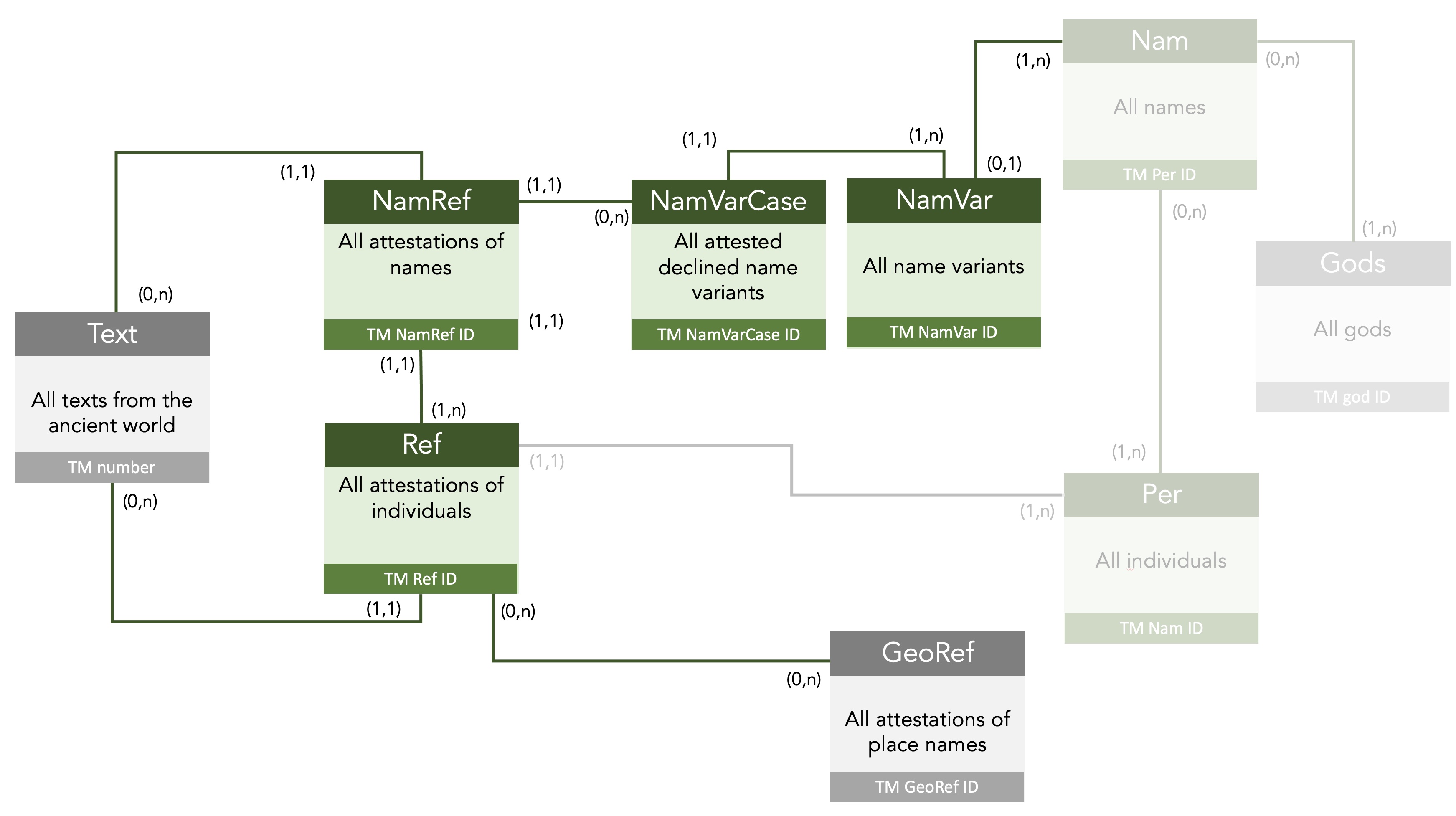Names in the ancient world is a tool dealing with personal names in the ancient Graeco-Roman world. In a first phase, as an offshoot of Trismegistos' participation in the Eagle project (see SNAP & NER below), it focuses on names in Latin inscriptions, except for the main Ptolemaic territories (Egypt, Cyrenaica and Cyprus), for which names in the Greek inscriptions from the Ptolemaic period have been added between 2010-2012. Starting from the Clauss / Slaby database, the Latin inscriptions are currently processed province by province, starting in North Africa (currently excluding Africa Proconsularis and Numidia, due to the large corpus there). The next region that will be tackled is the Eastern Mediterranean, starting with Arabia and Iudaea. Since this is a part-time, one-man show, progress is unfortunately slower than we would like, but we hope that what is available is already useful nonetheless.
In 2023, we will also start processing the personal names mentioned in ancient authors in light of the Networks of Ideas and Knowledge in the Ancient World [NIKAW] project (2022-2026). These names will also be integrated in this portal.

The underlying database of the Names in the ancient world portal consists of a complex set of tables. At the heart of the structure in the NamRef table, where each attestation of a separate personal name is collected (currently 27,892 records). This is linked to the Ref table, where clusters of names referring to the same individual are grouped together as attestations of individuals (currently 14,598 records). The onomastic structure consists of three tiers, dealing with names (NAM), name variants (NAMVAR), and declined name variants (NAMVARCASE) respectively. The Nam table currently has 39,847 names. Each of these standard names is connected to a set of variants, often in different languages / scripts, in the NamVar table (239,068 variants). For each of these variants, declined forms were created in the NamVarCase table. This last table is the largest, with 1,032,681 entries, and forms the link between REF and NAMVAR & NAM. The original TM People structure developed for the Egyptian data also includes a prosopographic Per table, but as explained below this is not a feature we will implement for other regions.
Please keep in mind that the Nam table (in contrast to the NamVar table) has only been fully developed for names attested in Egypt. Several Greek and Latin name variants attested in other regions will be linked to this table if they also appear in Egypt, but there is still a large group of variants without an overarching standard name record. This will improve in the future while we process more names, but for indigenous names this requires a thorough familiarity with local onomastic habits. Since we do not have this expertise, this is something we will not undertake ourselves, but we are happy to collaborate with other projects to set this up for particular languages/regions. Please
if you are interested!
The Names in the ancient world portal is not designed to become a prosopography of the ancient world. The focus is on (attestations of) personal names. We have therefore only developed the onomastic structure to standardize this data. Yet personal names obviously refer to people, and this component cannot be ignored completely. We have therefore retained the Ref level from the original TM People structure (which you can find here), a table where names that refer to a person in a single attestation (what we call an identification cluster) are grouped together. This table can be used as a starting point for other projects that would like to bring together prosopographies or even create new ones. Starting from this level of attestations has the benefit that different projects do not necessarily need to agree on prosopographical identifications. They are often tricky and speculative and require a lot of expertise on things such as imperial and local careers, regional epigraphic habits, etc. We will therefore not undertake such identifications ourselves, but aim to link to as many prosopographical projects as possible in order to guide our users to relevant information about the people behind the names. We currently already have links to the Lexicon of Greek Personal Names for Greek name variants, where prosopographical identifications have been made for each variant. For some other useful (online) prosopographies, see, for example, the Digital Prosopography of the Roman Republic, the Prosopography of the Byzantine Empire and Prosopography of the Byzantine World, and the original TM People for Hellenistic, Roman and Byzantine Egypt (more are listed on the Digital Classicist Wiki). If you would like to collaborate in order to show links to your project on our website, please
!
We hope that even in its current state the tool may prove useful enough to avert nemesis. Also, digital instruments such as this one have the advantage that they can be updated and improved easily. We would therefore be very grateful if users not only show clemency, but also help us improve the quality: suggestions and mistakes can be reported by clicking on 'Report an error' in the header above.
Online databases tend not to be quoted, or only reluctantly. Often scholars will not document the use of digital tools and point to the (printed version of the) sources directly. Gradually, however, scholarship seems to enter a new phase where online edition is taking over the front position from paper copy. For this purpose, we have developed stable numeric identifiers for each entry in each of the TM People tables. For more information, please consult the 'How to cite' section below.

